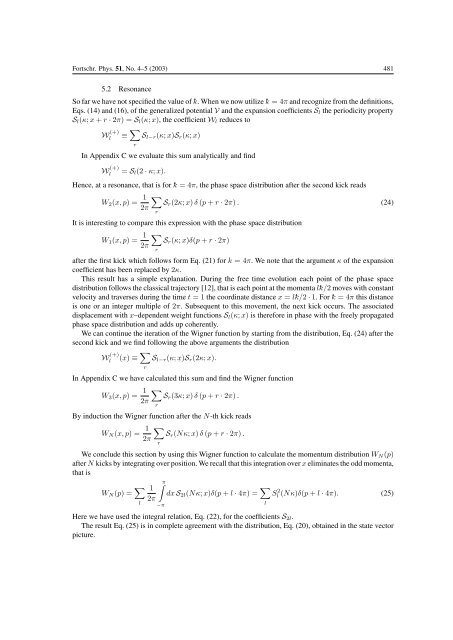Kicked rotor in Wigner phase space - The University of Texas at Austin
Kicked rotor in Wigner phase space - The University of Texas at Austin
Kicked rotor in Wigner phase space - The University of Texas at Austin
Create successful ePaper yourself
Turn your PDF publications into a flip-book with our unique Google optimized e-Paper software.
Fortschr. Phys. 51, No. 4–5 (2003) 481<br />
5.2 Resonance<br />
So far wehavenot specified thevalue<strong>of</strong> k- . When we now utilize k- =4πand recognizefrom thedef<strong>in</strong>itions,<br />
Eqs. (14) and (16), <strong>of</strong> the generalized potential V and the expansion coefficients Sl the periodicity property<br />
Sl(κ; x + r · 2π) =Sl(κ; x), the coefficient Wl reduces to<br />
<br />
≡ Sl−r(κ; x)Sr(κ; x)<br />
W (+)<br />
l<br />
r<br />
In Appendix C weevalu<strong>at</strong>ethis sum analytically and f<strong>in</strong>d<br />
W (+)<br />
l<br />
= Sl(2 · κ; x).<br />
Hence, <strong>at</strong> a resonance, th<strong>at</strong> is for k- =4π, the<strong>phase</strong><strong>space</strong>distribution after thesecond kick reads<br />
W2(x, p) = 1 <br />
Sr(2κ; x) δ (p + r · 2π) . (24)<br />
2π<br />
r<br />
It is <strong>in</strong>terest<strong>in</strong>g to comparethis expression with the<strong>phase</strong><strong>space</strong>distribution<br />
W1(x, p) = 1 <br />
Sr(κ; x)δ(p + r · 2π)<br />
2π<br />
r<br />
after the first kick which follows form Eq. (21) for k =4π. Wenoteth<strong>at</strong> theargument κ <strong>of</strong> theexpansion<br />
coefficient has been replaced by 2κ.<br />
This result has a simpleexplan<strong>at</strong>ion. Dur<strong>in</strong>g thefreetimeevolution each po<strong>in</strong>t <strong>of</strong> the<strong>phase</strong><strong>space</strong><br />
distribution follows the classical trajectory [12], th<strong>at</strong> is each po<strong>in</strong>t <strong>at</strong> the momenta lk - /2 moves with constant<br />
velocity and traverses dur<strong>in</strong>g the time t =1thecoord<strong>in</strong><strong>at</strong>edistancex = lk - /2 · 1.Fork - =4π this distance<br />
is oneor an <strong>in</strong>teger multiple<strong>of</strong> 2π. Subsequent to this movement, the next kick occurs. <strong>The</strong> associ<strong>at</strong>ed<br />
displacement with x–dependent weight functions Sl(κ; x) is therefore <strong>in</strong> <strong>phase</strong> with the freely propag<strong>at</strong>ed<br />
<strong>phase</strong><strong>space</strong>distribution and adds up coherently.<br />
Wecan cont<strong>in</strong>uetheiter<strong>at</strong>ion <strong>of</strong> the<strong>Wigner</strong> function by start<strong>in</strong>g from thedistribution, Eq. (24) after the<br />
second kick and wef<strong>in</strong>d follow<strong>in</strong>g theabovearguments thedistribution<br />
W (+)<br />
l<br />
(x) ≡ <br />
Sl−r(κ; x)Sr(2κ; x).<br />
r<br />
In Appendix C wehavecalcul<strong>at</strong>ed this sum and f<strong>in</strong>d the<strong>Wigner</strong> function<br />
W3(x, p) = 1 <br />
Sr(3κ; x) δ (p + r · 2π) .<br />
2π<br />
r<br />
By <strong>in</strong>duction the <strong>Wigner</strong> function after the N-th kick reads<br />
WN(x, p) = 1 <br />
Sr(Nκ; x) δ (p + r · 2π) .<br />
2π<br />
r<br />
Weconcludethis section by us<strong>in</strong>g this <strong>Wigner</strong> function to calcul<strong>at</strong>ethemomentum distribution WN(p)<br />
after N kicks by <strong>in</strong>tegr<strong>at</strong><strong>in</strong>g over position. We recall th<strong>at</strong> this <strong>in</strong>tegr<strong>at</strong>ion over x elim<strong>in</strong><strong>at</strong>es the odd momenta,<br />
th<strong>at</strong> is<br />
WN(p) = <br />
π<br />
1<br />
dx S2l(Nκ; x)δ(p + l · 4π) =<br />
2π<br />
<br />
S 2 l (Nκ)δ(p + l · 4π). (25)<br />
l<br />
−π<br />
Herewehaveused the<strong>in</strong>tegral rel<strong>at</strong>ion, Eq. (22), for thecoefficients S2l.<br />
<strong>The</strong> result Eq. (25) is <strong>in</strong> complete agreement with the distribution, Eq. (20), obta<strong>in</strong>ed <strong>in</strong> the st<strong>at</strong>e vector<br />
picture.<br />
l
















